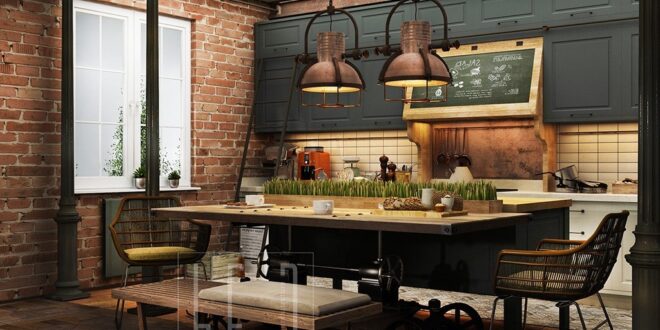Embracing the Industrial Revolution in Your Kitchen: A Style Guide
The industrial style kitchen. It’s more than just a design trend; it’s a statement. A bold declaration that celebrates raw materials, functional design, and a touch of urban grit. Imagine exposed brick, gleaming metal accents, and a sense of utilitarian chic that feels both modern and timeless. If you’re drawn to spaces that tell a story, that feel lived-in and authentic, then the industrial kitchen might just be your design soulmate.

But where do you even begin? Transforming your current kitchen into an industrial haven can seem daunting, but fear not! This comprehensive guide will walk you through every step, from understanding the core principles to implementing clever design hacks. We’ll explore the key elements, delve into material choices, and offer practical tips to create an industrial kitchen that perfectly reflects your personal style.
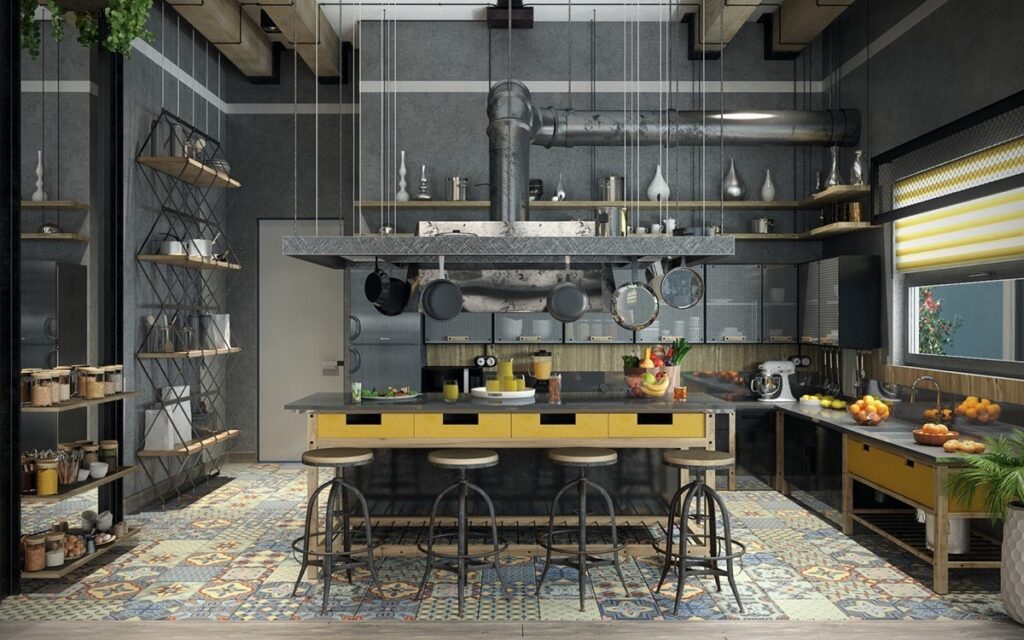
Understanding the Core Principles of Industrial Kitchen Design
Before diving headfirst into demolition and renovation, it’s crucial to understand the fundamental principles that define the industrial aesthetic. These principles act as guiding stars, ensuring your design choices remain true to the style’s essence.

1. Raw and Unfinished Materials: The Heart of the Look
Think exposed brick, concrete floors, and unfinished wood. These materials are the building blocks of the industrial style. They bring texture, depth, and a sense of authenticity to the space. The imperfections are not flaws but rather features that add character and charm. Embrace the natural variations in the materials, the knots in the wood, the slight imperfections in the concrete. They tell a story of creation and age, adding a unique dimension to your kitchen.
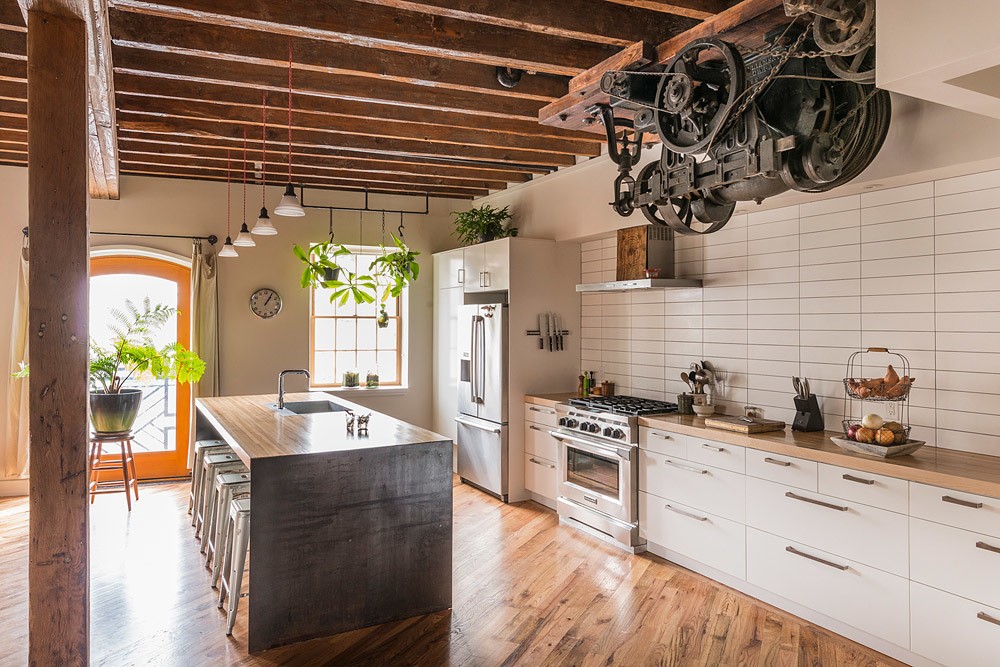
2. Functionality and Minimalism: Less is Often More
Industrial design is rooted in practicality. Every element should serve a purpose. Avoid clutter and unnecessary ornamentation. Focus on clean lines, simple shapes, and functional layouts. The goal is to create a space that is efficient, easy to use, and visually uncluttered. Think about the tools and equipment used in factories and workshops. They were designed for functionality, not aesthetics, and that same principle applies to the industrial kitchen.
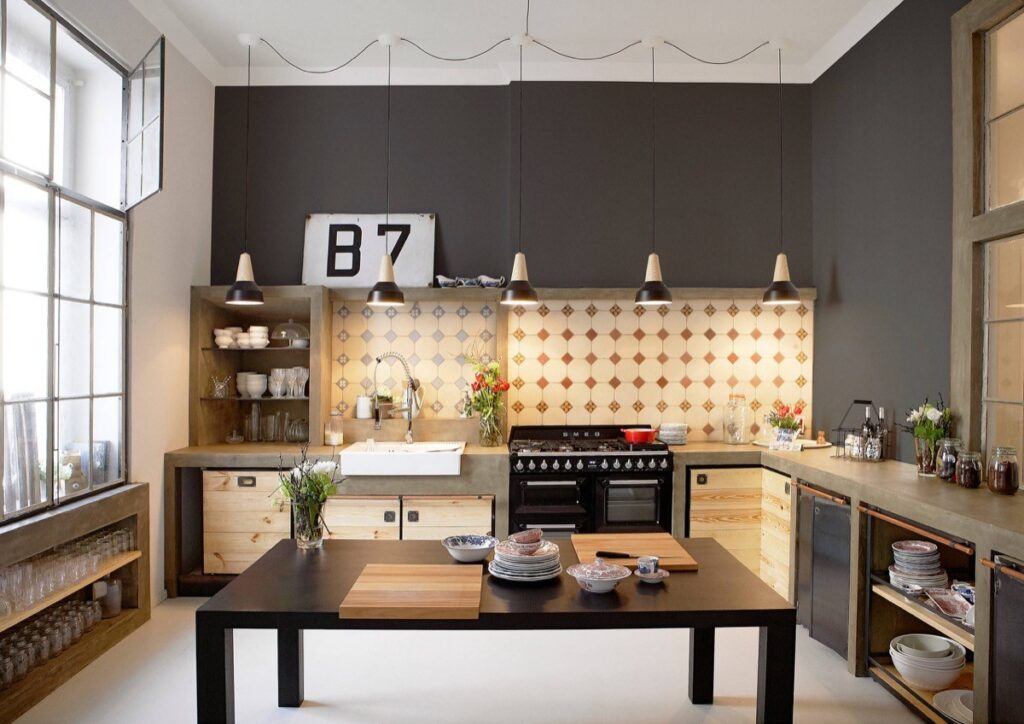
3. Open Space and Exposed Elements: Letting It All Hang Out
Industrial spaces often feature open floor plans and exposed structural elements. This means showcasing things like pipes, ductwork, and beams instead of concealing them behind walls and ceilings. This creates a sense of spaciousness and reveals the building’s inner workings. It’s about honesty and transparency in design, showing the underlying structure rather than hiding it. If you have exposed brick or concrete walls, embrace them! They are valuable assets in creating an authentic industrial look.

4. Metal Accents: Adding a Touch of Gleaming Grittiness
Metal is a key component of the industrial aesthetic. Stainless steel, iron, and copper are all excellent choices. Use them for countertops, backsplashes, lighting fixtures, and hardware. Metal adds a touch of coolness and sophistication to the space. Consider using reclaimed metal for an extra dose of authenticity and character. The contrast between the raw materials and the sleek metal accents creates a visually striking and balanced effect.
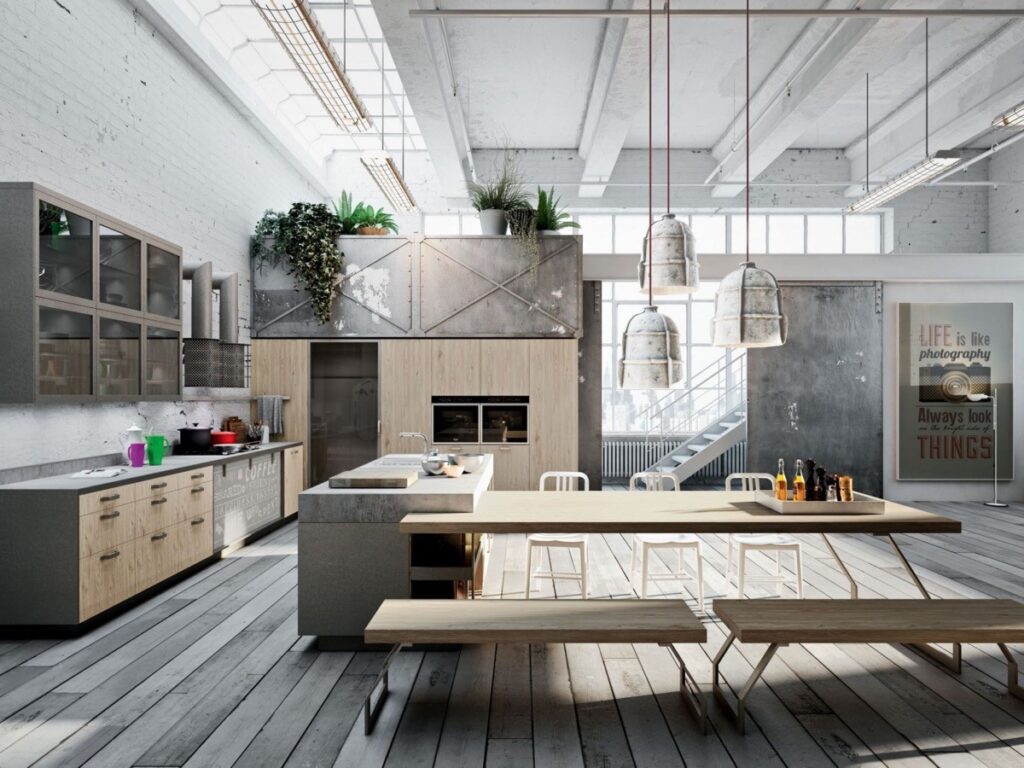
5. Neutral Color Palette: A Backdrop for Industrial Beauty
The industrial style typically relies on a neutral color palette. Think grays, whites, blacks, and browns. These colors create a calm and understated backdrop that allows the raw materials and metal accents to shine. Pops of color can be introduced through artwork, accessories, or even colorful cookware, but the overall palette should remain neutral and grounded. A neutral backdrop also provides flexibility, allowing you to easily change the look of your kitchen with different accessories and accents.

Material Choices for Your Industrial Kitchen
Selecting the right materials is crucial to achieving an authentic industrial look. Here’s a breakdown of some of the most popular and effective material choices:
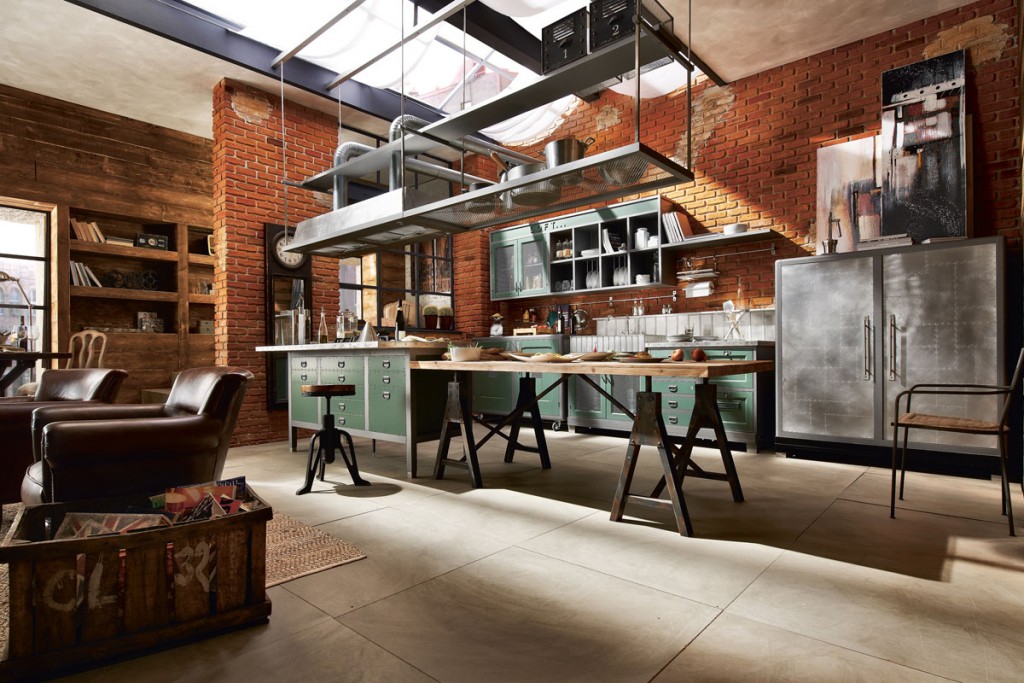
1. Concrete: The Undisputed King of Industrial Flooring and Countertops
Concrete is a versatile and durable material that is perfect for industrial kitchens. It can be used for flooring, countertops, and even backsplashes. Concrete floors are easy to clean and maintain, and they provide a solid and grounded foundation for the space. Concrete countertops offer a sleek and modern look, and they can be customized with different finishes and colors. Consider polished concrete for a smooth and refined look, or leave it rough and textured for a more rustic feel. Remember to seal concrete to prevent staining and damage.
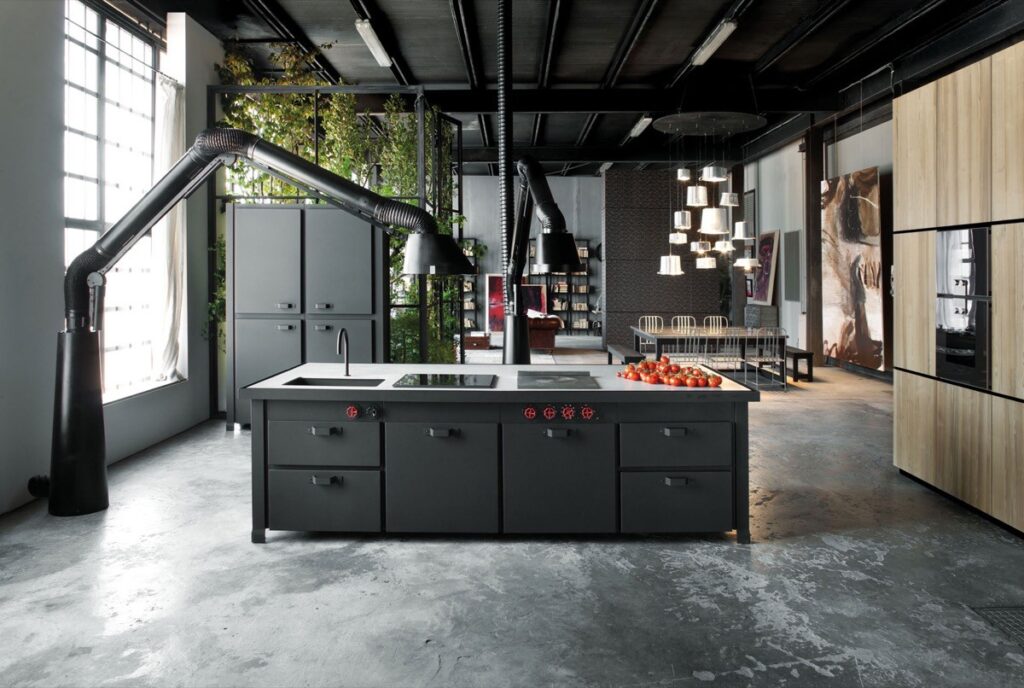
2. Exposed Brick: A Touch of Urban History
Exposed brick is a classic industrial element that adds character and warmth to any kitchen. If you’re lucky enough to have exposed brick walls, embrace them! If not, you can create the look by installing brick veneer or faux brick panels. Exposed brick provides a beautiful contrast to the sleek metal accents and modern appliances. Consider painting the brick white or gray for a more contemporary look, or leave it natural for a more rustic feel. Brick can also be used for backsplashes, creating a textured and visually interesting focal point.
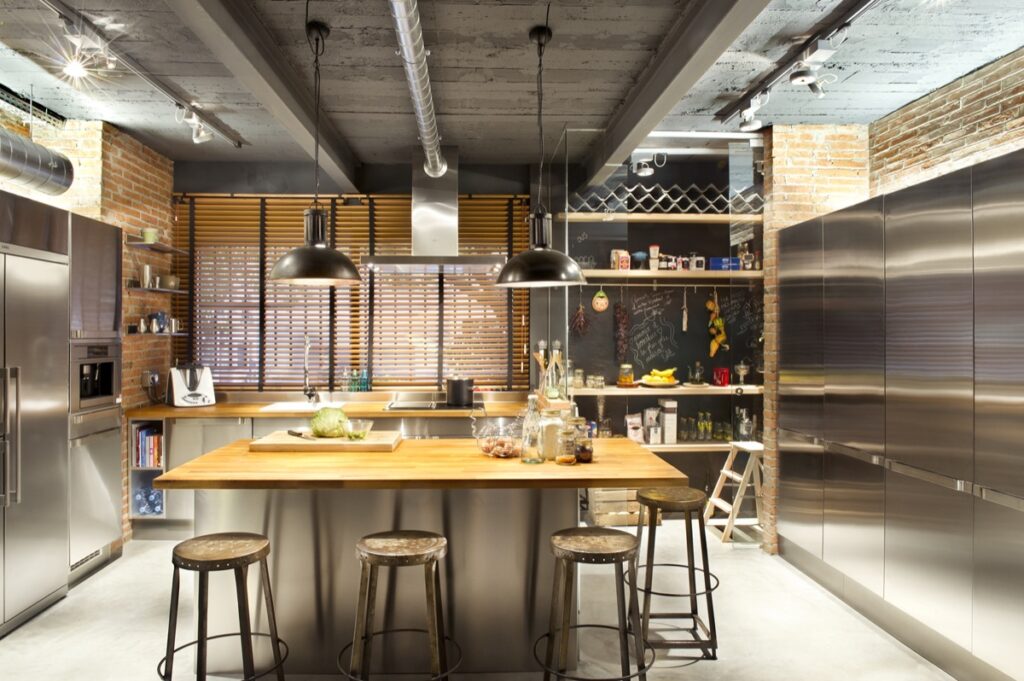
3. Stainless Steel: The Workhorse of the Industrial Kitchen
Stainless steel is a durable, hygienic, and easy-to-clean material that is perfect for kitchen appliances, countertops, and backsplashes. It adds a touch of coolness and sophistication to the space. Stainless steel appliances are a must-have in any industrial kitchen. Consider using stainless steel countertops for a sleek and modern look, or use it as a backsplash for easy cleaning and maintenance. Stainless steel shelving is also a great way to display cookware and utensils while maintaining the industrial aesthetic.
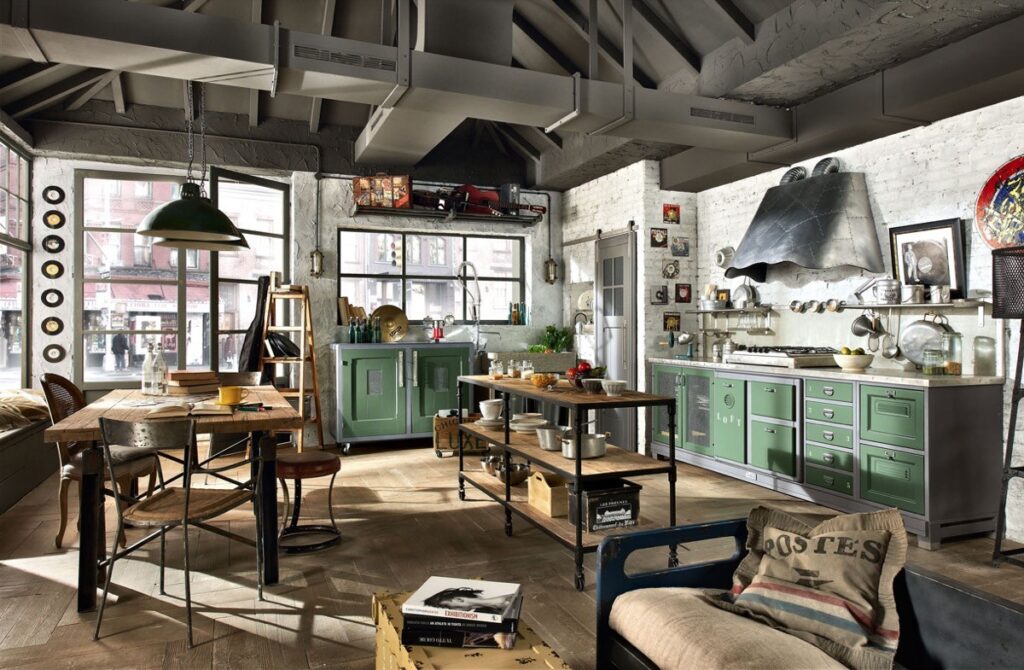
4. Wood: Adding Warmth and Texture to the Industrial Landscape
While metal and concrete dominate the industrial aesthetic, wood plays a crucial role in adding warmth and texture to the space. Reclaimed wood is an excellent choice for cabinets, shelving, and countertops. It adds character and history to the kitchen, and it’s a sustainable and eco-friendly option. Consider using butcher block countertops for a warm and inviting feel, or use wooden shelves to display your favorite cookbooks and kitchen accessories. The contrast between the rough wood and the sleek metal accents creates a balanced and visually appealing space.
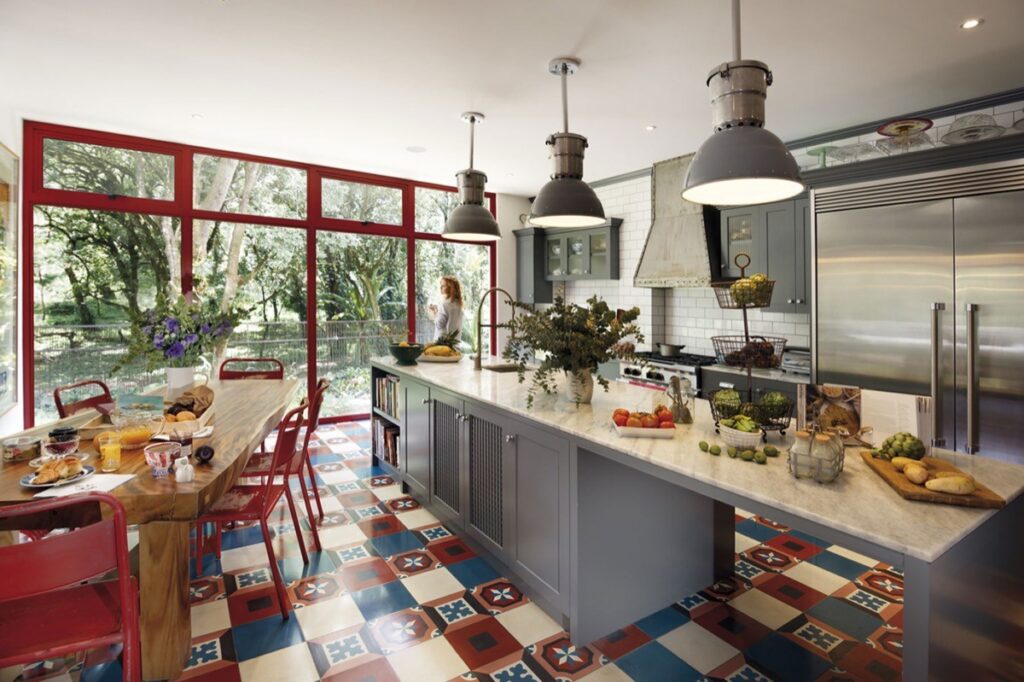
5. Metal Mesh and Wire: Industrial Details That Make a Difference
Metal mesh and wire are often overlooked, but they can add a subtle yet impactful industrial touch to your kitchen. Use metal mesh for cabinet doors, pendant lights, or even as a decorative accent on walls. Wire shelving is another great way to display items while maintaining the industrial aesthetic. These details add texture and visual interest to the space, and they tie in with the overall industrial theme.
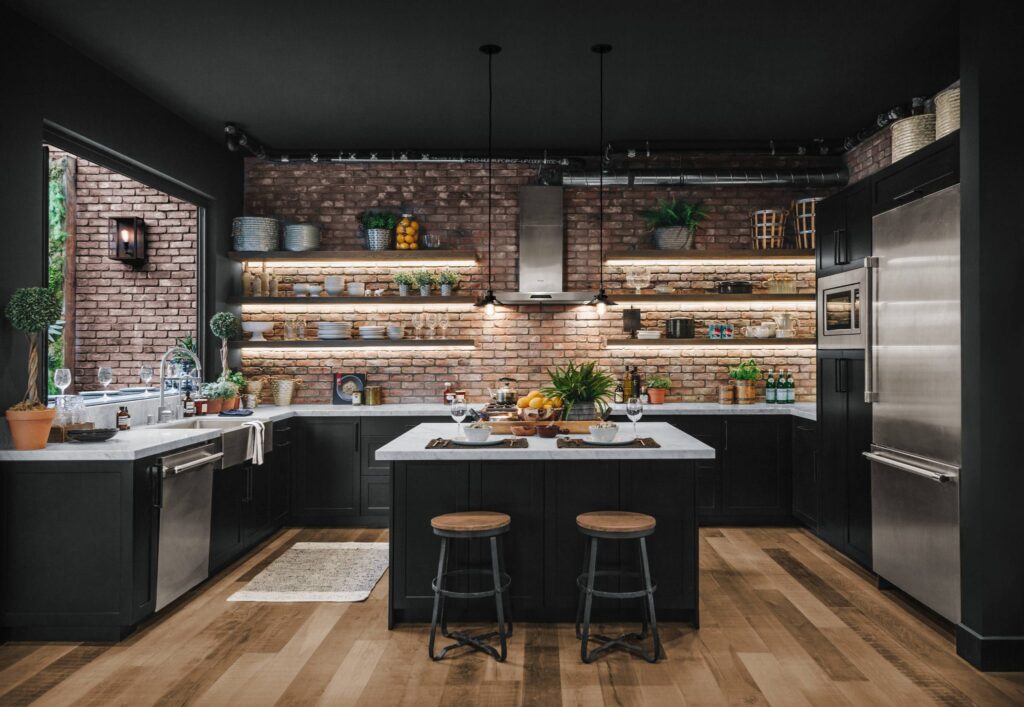
Industrial Kitchen Design Ideas: From Small Touches to Full Renovations
Now that you understand the core principles and material choices, let’s explore some specific design ideas that you can incorporate into your industrial kitchen:
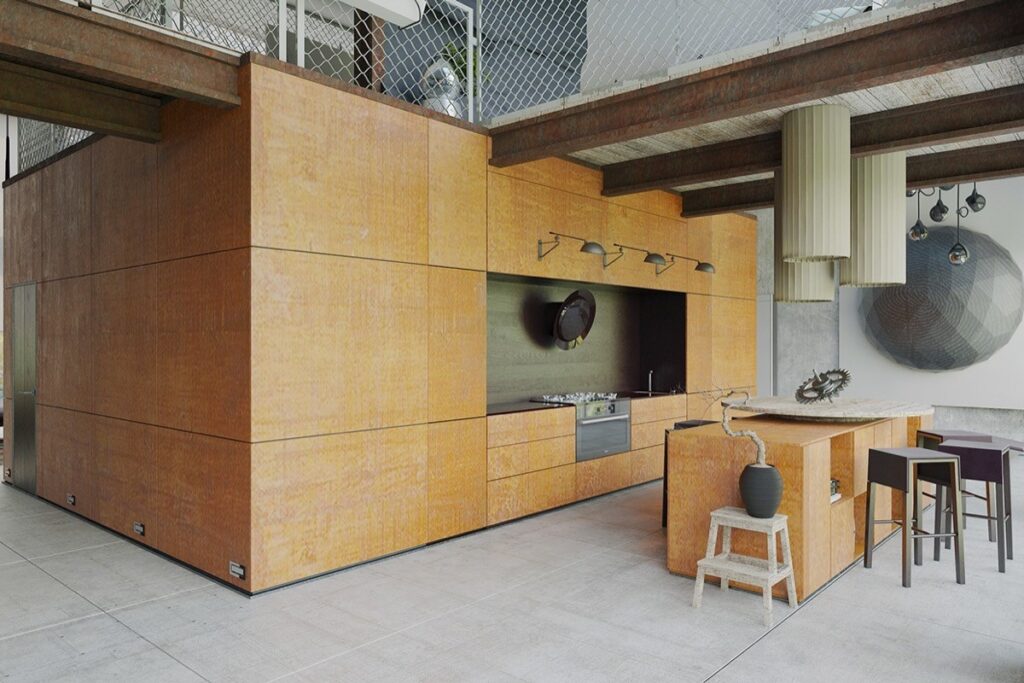
1. Lighting: Illuminating the Industrial Space
Lighting is a crucial element in any kitchen design, and it’s especially important in the industrial style. Pendant lights with exposed bulbs are a classic choice. Look for fixtures made from metal, such as iron or copper. Consider using Edison bulbs for a vintage-inspired look. Track lighting is another great option for providing ample illumination. Install track lighting along the ceiling to highlight different areas of the kitchen. Task lighting is also essential for food preparation. Under-cabinet lighting can provide targeted illumination for countertops and cooking areas.
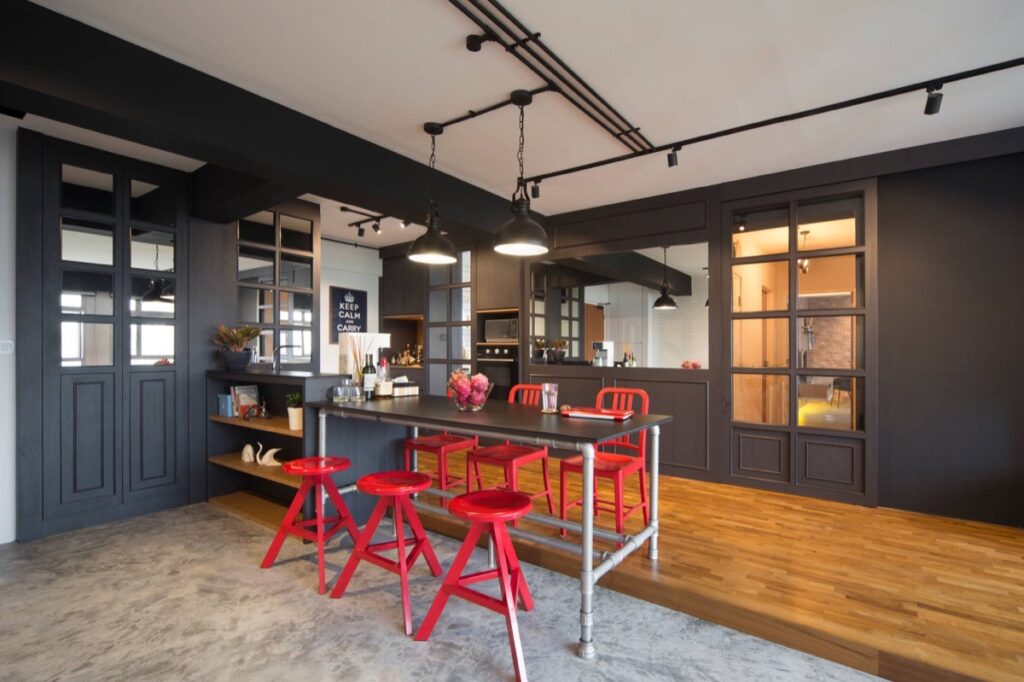
2. Open Shelving: Displaying Your Culinary Treasures
Open shelving is a hallmark of the industrial kitchen. It allows you to display your favorite cookware, dishes, and utensils while keeping them within easy reach. Use metal shelves, wooden shelves, or a combination of both. Arrange your items in a visually appealing way, creating a curated and stylish display. Open shelving also provides an opportunity to add pops of color and texture to the space.
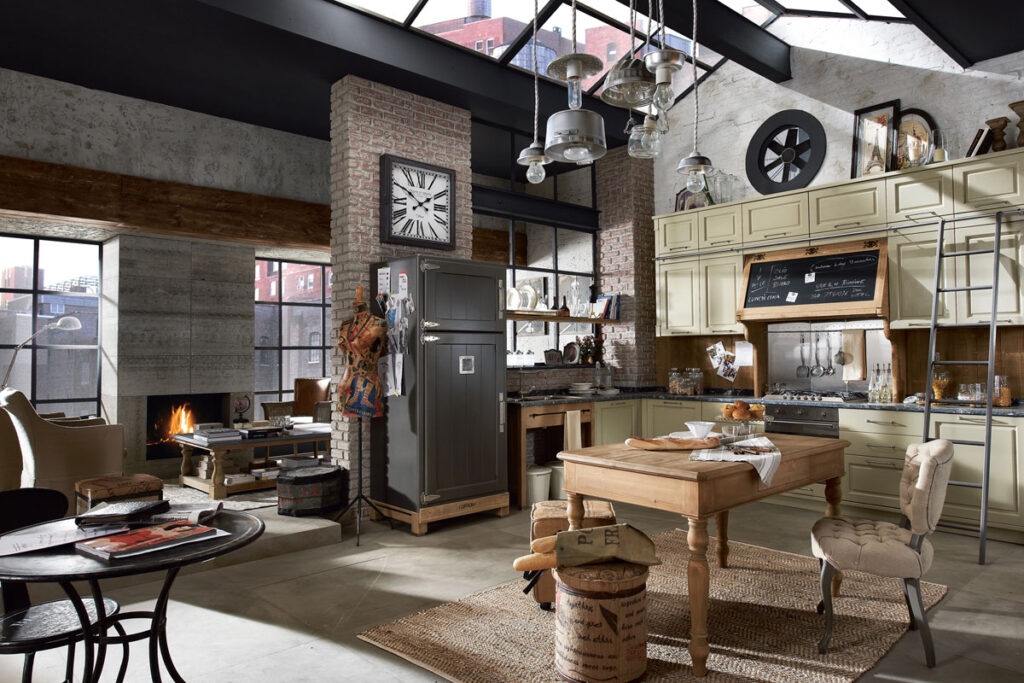
3. Kitchen Islands: The Hub of the Industrial Kitchen
A kitchen island is a functional and stylish addition to any kitchen, and it’s especially well-suited for the industrial style. Choose an island with a concrete countertop or a butcher block top. Consider adding a metal base for an industrial touch. The island can serve as a prep area, a dining space, or a gathering spot for family and friends. Add bar stools with metal frames for a cohesive look.
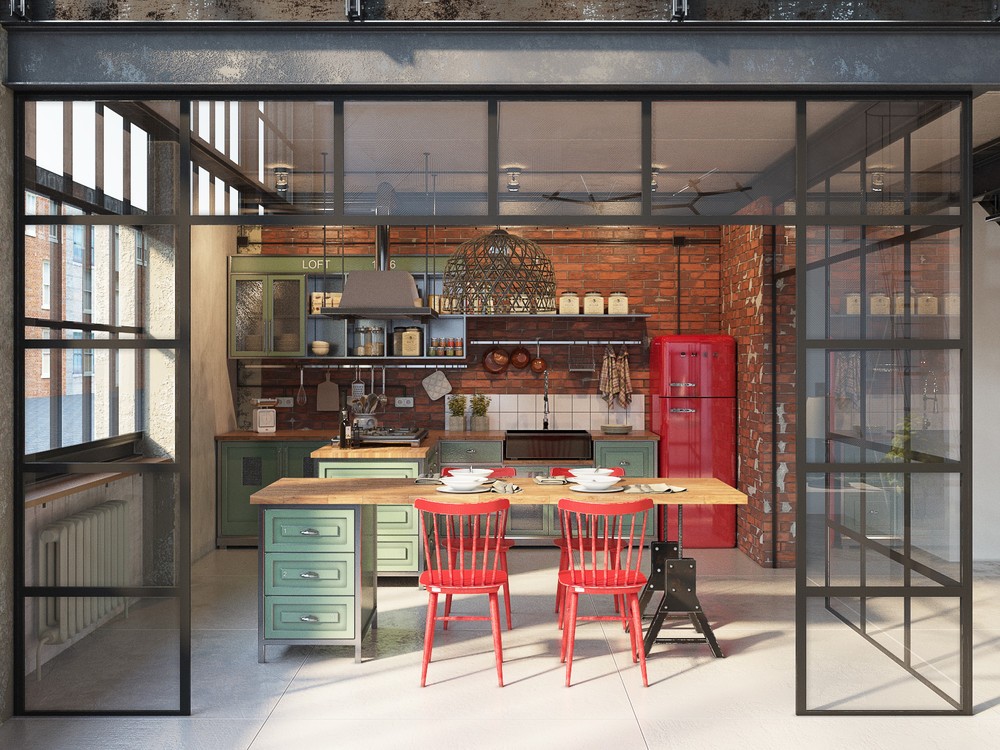
4. Backsplashes: Adding Texture and Visual Interest
The backsplash is a great opportunity to add texture and visual interest to your industrial kitchen. Consider using exposed brick, subway tiles, or stainless steel for your backsplash. Subway tiles are a classic choice that complements the industrial aesthetic. Stainless steel is easy to clean and maintain, and it adds a touch of coolness to the space. Exposed brick provides a rustic and textured backdrop.
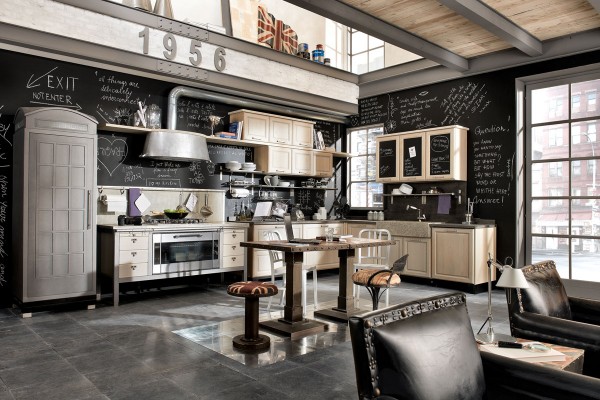
5. Hardware: The Finishing Touches That Make a Difference
The hardware is often overlooked, but it can make a big difference in the overall look of your industrial kitchen. Choose hardware made from metal, such as iron or stainless steel. Look for simple and functional designs. Knobs and pulls with a matte finish will complement the industrial aesthetic. Consider using reclaimed hardware for an extra dose of authenticity and character.
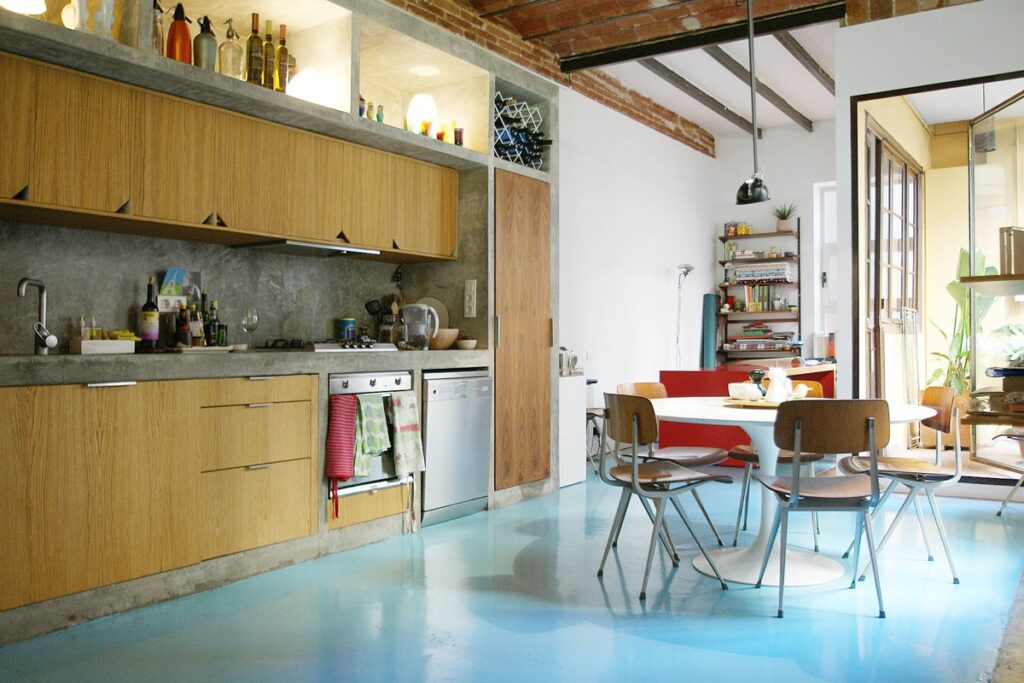
6. Furniture and Accessories: Completing the Look
Choose furniture and accessories that complement the industrial aesthetic. Metal bar stools, wooden chairs, and vintage-inspired accessories will add character and charm to the space. Consider adding a chalkboard wall for writing grocery lists or displaying artwork. Use metal containers for storing utensils and spices. Add plants to bring a touch of nature into the kitchen. The key is to create a space that feels both functional and stylish.
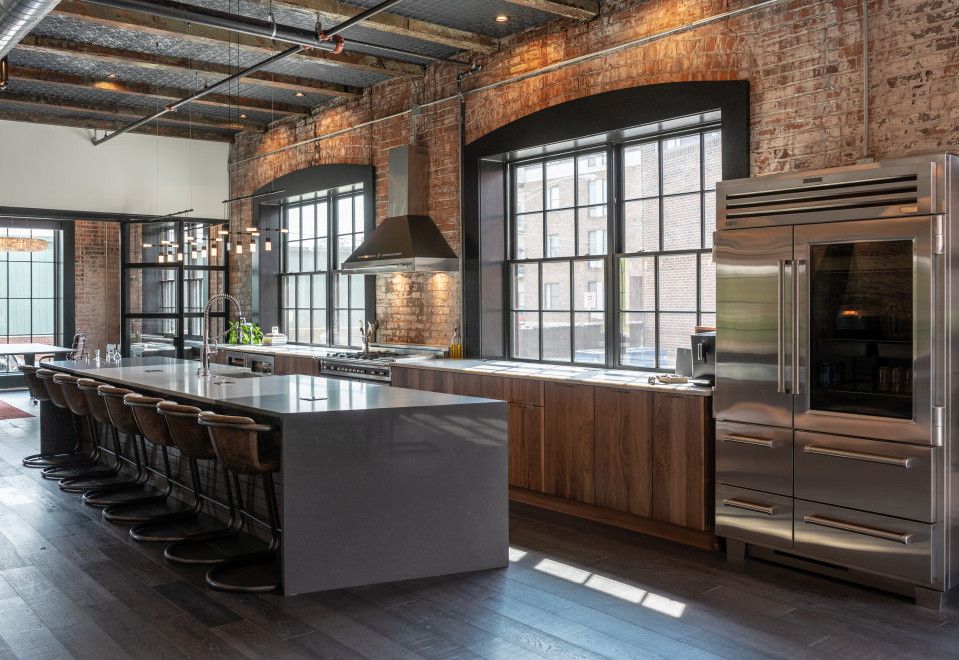
DIY Industrial Kitchen Projects: Adding Your Personal Touch
If you’re on a budget or simply enjoy DIY projects, there are plenty of ways to add an industrial touch to your kitchen without breaking the bank:

1. DIY Pipe Shelving: A Rustic and Affordable Storage Solution
Create your own industrial-style shelving using metal pipes and wooden planks. This is a relatively easy and affordable project that can add a lot of character to your kitchen. Simply purchase metal pipes and fittings from your local hardware store, and cut wooden planks to the desired size. Assemble the shelving unit and attach it to the wall. You can paint the pipes black or leave them unfinished for a more rustic look.
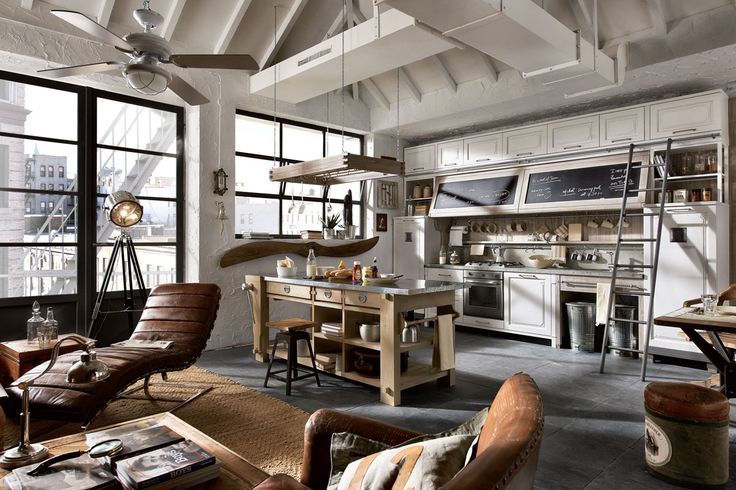
2. DIY Concrete Countertops: A Bold and Modern Statement
While creating concrete countertops can be a bit more involved, it’s a rewarding project that can save you a lot of money. You’ll need to build a mold for the countertop, mix the concrete, pour it into the mold, and let it cure. Once the concrete is cured, you can sand it and seal it. This project requires some DIY experience and attention to detail, but the results can be stunning.
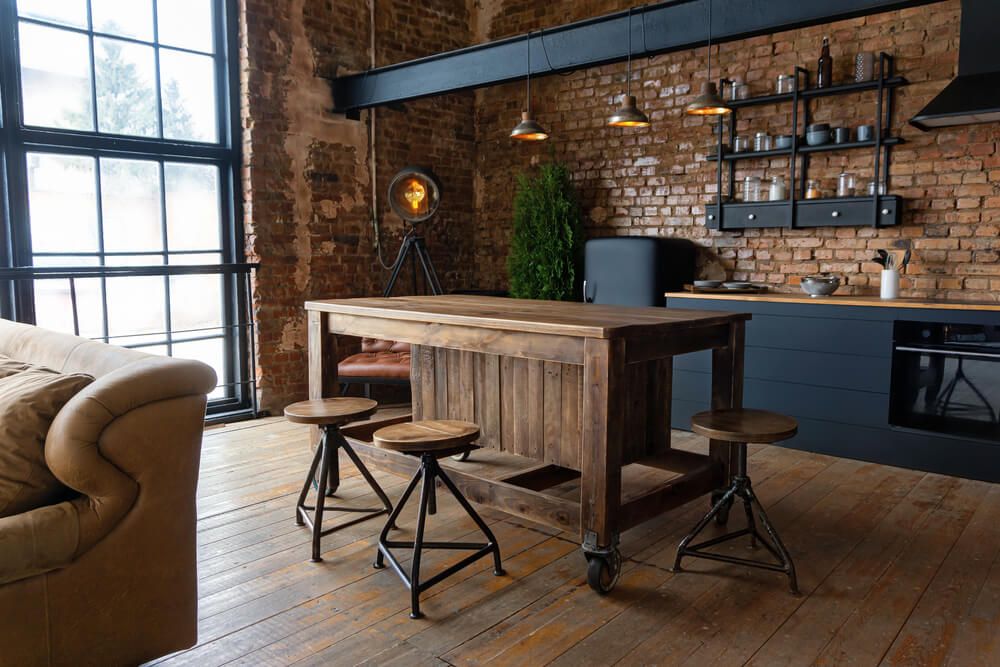
3. DIY Metal Backsplash: A Sleek and Easy-to-Clean Option
Create your own metal backsplash using sheets of stainless steel or aluminum. Simply cut the metal to the desired size and attach it to the wall using construction adhesive. This is a relatively easy and affordable project that can add a touch of coolness to your kitchen. You can also use corrugated metal for a more textured and industrial look.

4. Upcycled Lighting Fixtures: Giving Old Items a New Life
Transform old items into unique and industrial-inspired lighting fixtures. Use old mason jars, metal cages, or even plumbing pipes to create your own pendant lights or sconces. This is a great way to add character and personality to your kitchen while saving money.
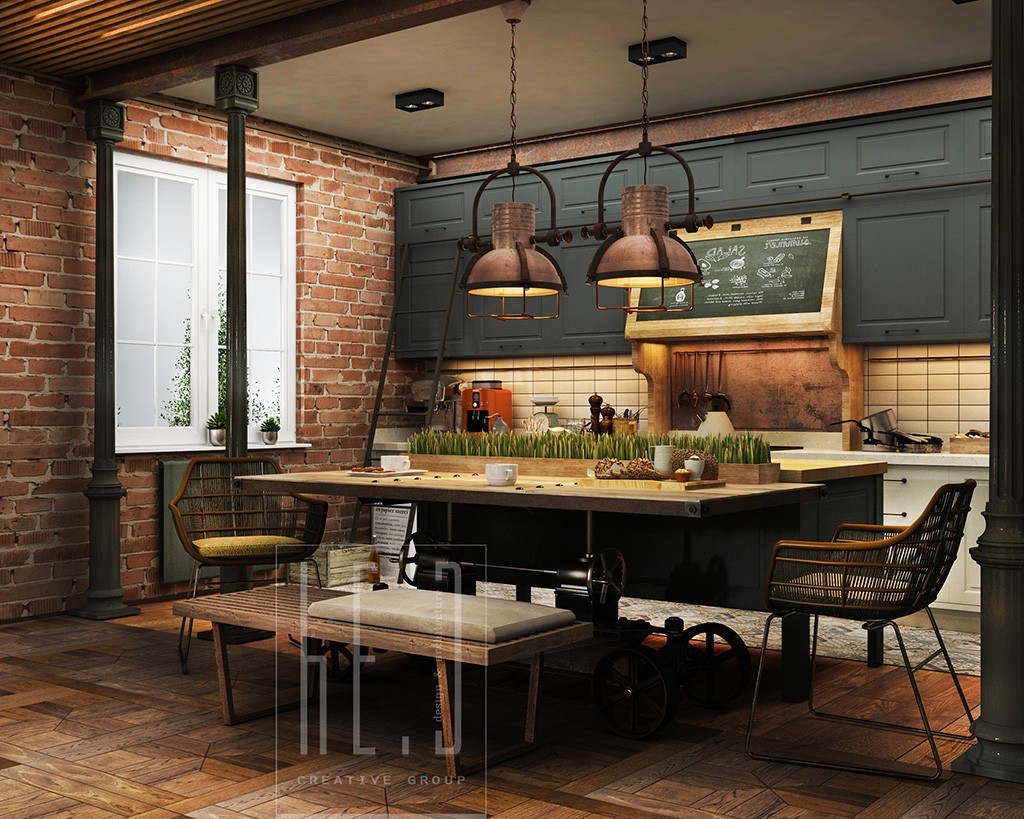
Maintaining Your Industrial Kitchen: Keeping It Looking Its Best
Once you’ve created your dream industrial kitchen, it’s important to maintain it properly to keep it looking its best. Here are some tips for maintaining your industrial kitchen:
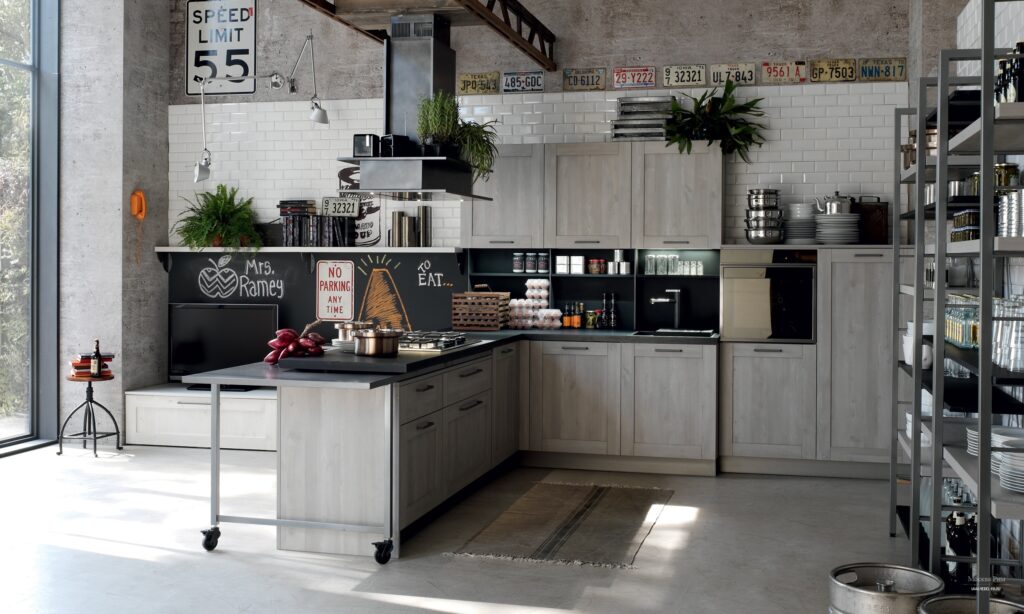
1. Cleaning Concrete: Preventing Stains and Damage
Concrete is a porous material, so it’s important to seal it properly to prevent staining and damage. Clean concrete surfaces regularly with a mild detergent and water. Avoid using harsh chemicals or abrasive cleaners, as they can damage the sealant. If you spill something on concrete, clean it up immediately to prevent staining.
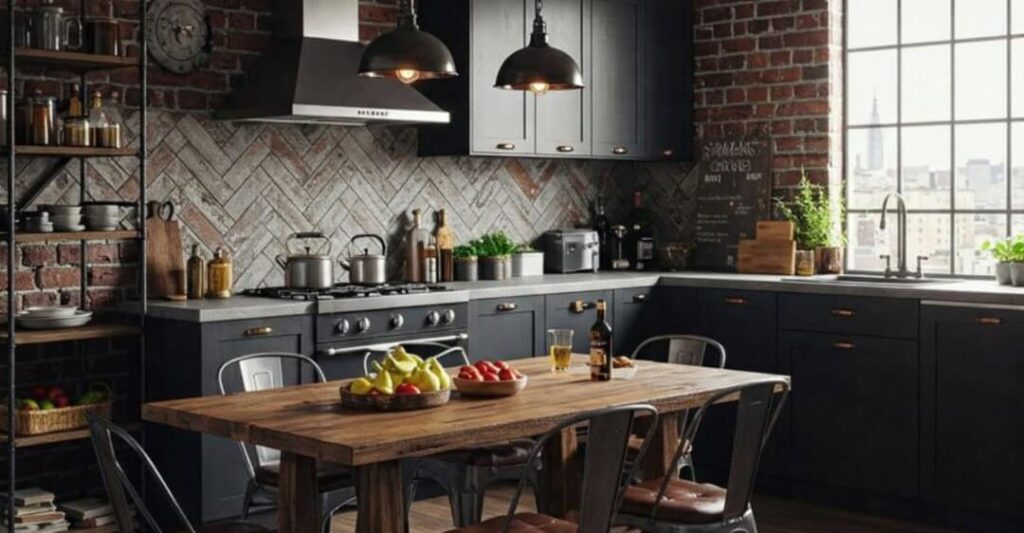
2. Cleaning Stainless Steel: Removing Fingerprints and Grime
Stainless steel is easy to clean and maintain, but it can show fingerprints and smudges. Clean stainless steel surfaces regularly with a stainless steel cleaner or a mixture of vinegar and water. Wipe the surface dry with a clean cloth to prevent water spots.
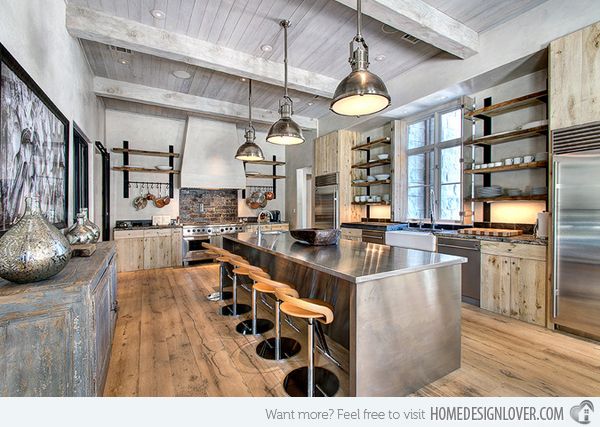
3. Caring for Wood: Protecting It from Moisture and Damage
Wood is a natural material that can be affected by moisture and heat. Protect wooden countertops and shelves from moisture by wiping up spills immediately. Avoid placing hot items directly on wooden surfaces. Apply a sealant or finish to wood surfaces to protect them from damage.

4. Maintaining Exposed Brick: Preventing Crumbling and Dust
Exposed brick can accumulate dust and debris over time. Clean exposed brick surfaces regularly with a brush or vacuum cleaner. Consider sealing the brick to prevent crumbling and dust. If you have painted brick, touch up the paint as needed to keep it looking fresh.
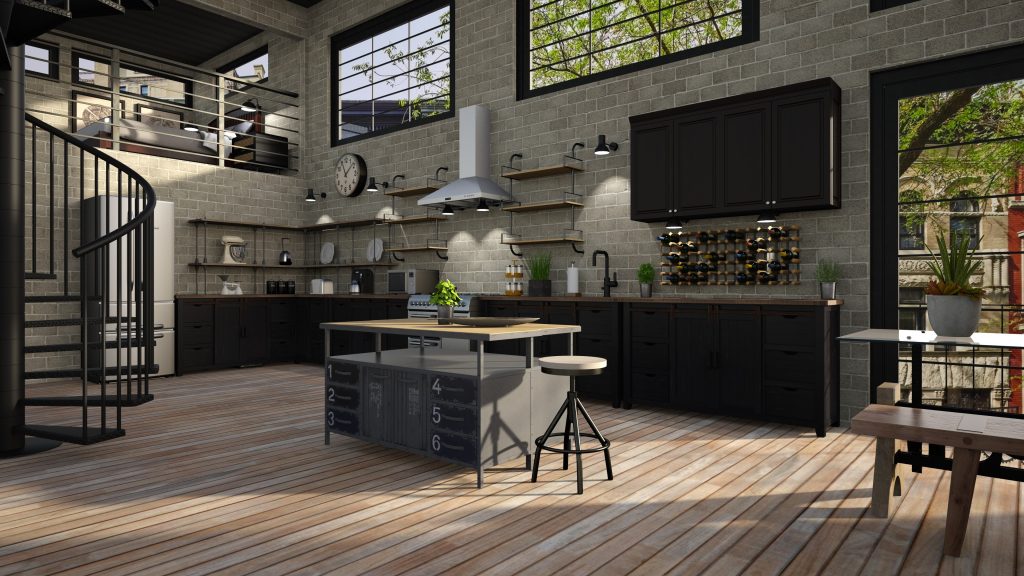
Conclusion: Creating an Industrial Kitchen That’s Uniquely Yours
Creating an industrial style kitchen is all about embracing raw materials, functional design, and a touch of urban grit. By understanding the core principles, selecting the right materials, and incorporating clever design ideas, you can transform your kitchen into a stylish and functional space that reflects your personal style. Don’t be afraid to experiment and add your own unique touches. The most important thing is to create a kitchen that you love and that you’ll enjoy for years to come. So, unleash your inner designer and get ready to embrace the raw elegance of the industrial kitchen!
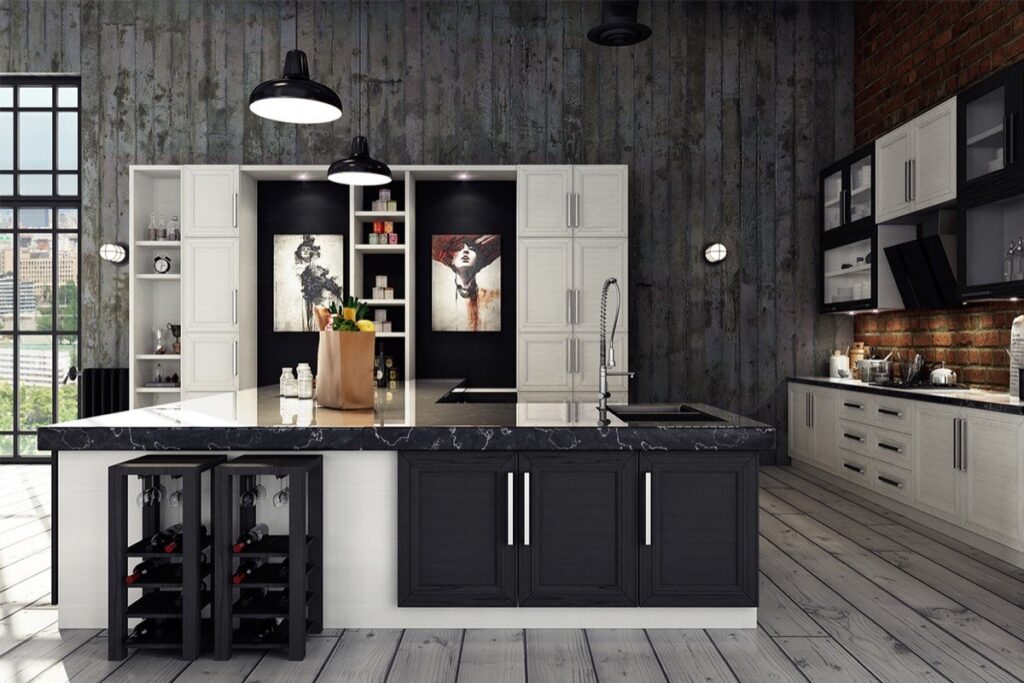
 Nimila
Nimila
